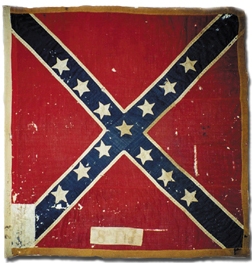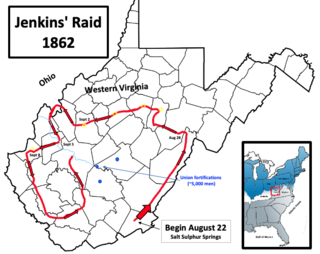
The U.S. state of West Virginia was formed out of western Virginia and added to the Union as a direct result of the American Civil War, in which it became the only modern state to have declared its independence from the Confederacy. In the summer of 1861, Union troops, which included a number of newly formed Western Virginia regiments, under General George McClellan drove off Confederate troops under General Robert E. Lee at the Battle of Philippi in Barbour County. This essentially freed Unionists in the northwestern counties of Virginia to form a functioning government of their own as a result of the Wheeling Convention. Before the admission of West Virginia as a state, the government in Wheeling formally claimed jurisdiction over all of Virginia, although from its creation it was firmly committed to the formation of a separate state.
The 5th West Virginia Infantry Regiment was an infantry regiment that served in the Union Army during the American Civil War.
The 8th West Virginia Infantry Regiment was an infantry regiment that served in the Union Army during the American Civil War.
The 9th West Virginia Infantry Regiment was an infantry regiment that served in the Union Army during the American Civil War.
The 12th West Virginia Infantry Regiment was an infantry regiment that served in the Union Army during the American Civil War. The regiment was particularly distinguished for its successful attack on Fort Gregg during the 1864 to 1865 Siege of Petersburg, receiving a golden eagle for its flagstaff as a token of appreciation from corps commander John Gibbon.

The 2nd West Virginia Cavalry Regiment served in the Union Army during the American Civil War. It was organized in Parkersburg, Virginia during September 1861. Most of the original members of this regiment were from southeastern Ohio, and planners thought that this regiment would become the 4th Ohio Cavalry. Their application was rejected by the governor of Ohio, so the unit became the 2nd Regiment of Loyal Virginia Volunteer Cavalry. The "Loyal Virginia" part of the name was replaced with "West Virginia" after the state of West Virginia was officially admitted to the Union in 1863. Today, the National Park Service lists them as 2nd Regiment, West Virginia Cavalry under a heading of Union West Virginia Volunteers.
The 23rd Illinois Volunteer Infantry Regiment, known as the "First Irish" or "Irish 'Brigade'", was an infantry regiment that served in the Union Army during the American Civil War.

The 3rd Arkansas Infantry Regiment, commonly known as the "Third Arkansas", was a line infantry formation of the Confederate States Army in the Eastern Theater of the American Civil War.

The 22nd Virginia Infantry Regiment was an infantry regiment from the western Virginia that served in the Confederate States Army during the American Civil War. Its commander was George S. Patton Sr., the grandfather of World War II General George S. Patton.

The 91st New York Infantry Regiment was a state infantry regiment formed during the American Civil War from counties around Albany, New York.
The 11th Ohio Infantry Regiment was an infantry regiment in the Union Army during the American Civil War.

The 36th Virginia Infantry Regiment was an infantry regiment mostly raised in the Kanawha Valley for service in the Confederate States Army during the American Civil War. It fought mostly in western Virginia, Tennessee, and Kentucky.

The 26th Virginia Infantry Battalion was a unit of the Confederate States Army organized on May 20, 1862 from men of the 59th Virginia Infantry Regiment who were not captured at the Battle of Roanoke Island and additional companies of recruits. It was commanded by Lt. Col. George M. Edgar and, after his capture in 1864, by Capt. Edmund S. Read. The battalion was disbanded on April 12, 1865 by Brig. Gen. John Echols at Christiansburg, Va.
The 28th Ohio Infantry Regiment was an infantry regiment in the Union Army during the American Civil War. It was frequently referred to as the 2nd German Ohio Regiment.
The 123rd Ohio Infantry Regiment, sometimes 123rd Ohio Volunteer Infantry was an infantry regiment in the Union Army during the American Civil War.
The western Virginia campaign, also known as operations in western Virginia or the Rich Mountain campaign, occurred from May to December 1861 during the American Civil War. Union forces under Major General George B. McClellan invaded the western portion of Virginia to prevent Confederate occupation; this area later became the state of West Virginia. West Virginians on both sides would fight in the campaign while a Unionist convention in Wheeling would appoint their choice for a Unionist governor for Virginia, Francis H. Pierpont, and promote the creation of a new state in western Virginia. Large scale Confederate forces would gradually abandon the region, leaving it to small local brigades to maintain hold on southern and eastern sections for much of the war.

The 8th Florida Infantry Regiment was a unit of the Confederate States Army during the American Civil War. Serving in the Army of Northern Virginia throughout the war; it fought in most battles of the Eastern Theater.

William Henry Powell was an American soldier who fought for the Union in the American Civil War. He was a leader in the iron and nail business before the war, and his leadership abilities proved useful in the military. Powell began as a captain, and quickly ascended to higher roles in the cavalry, including commanding a regiment, a brigade, and then a division. Powell was awarded his country's highest award for bravery during combat, the Medal of Honor, for heroism at Sinking Creek, Virginia, when, as leader of a group of 22 men, he captured an enemy camp and took over 100 prisoners. This was accomplished without the loss of any of his men on November 26, 1862. He was honored with the award on July 22, 1890.
Daniel Edward Frost was an American journalist, politician and soldier who twice served in the Virginia House of Delegates before the American Civil War. He helped found the state of West Virginia at the Wheeling Convention where he represented Jackson County and served as Speaker of the House of Delegates for the Virginia General Assembly at Wheeling, before he died fighting for the Union while leading the 11th West Virginia Infantry Regiment.

Jenkins' Trans-Allegheny Raid was a Confederate cavalry expedition in the American Civil War that took place in Western Virginia and Ohio during August and September 1862. The raid was led by Brigadier General Albert G. Jenkins, and it started on August 22 as a preliminary step in Confederate Major General William W. Loring's military campaign to drive the Union Army out of the Kanawha River Valley. That campaign, known as the Kanawha Valley Campaign of 1862, took place from September 6 through September 16. The purpose of Jenkins' raid was to get behind the Union Army outposts located near the beginning of the Kanawha River, and cut off their main route of retreat to the safety of Ohio.







